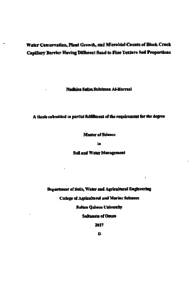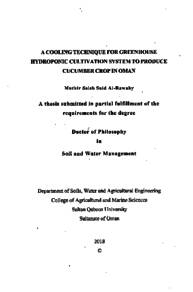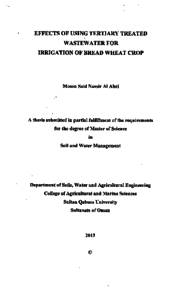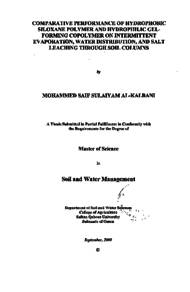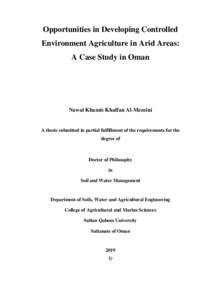وثيقة
Water conservation, plant growth, and microbial counts of block crack capillary barrier having different sand to fine texture soil proportions
الناشر
Sultan Qaboos University
ميلادي
2017
اللغة
الأنجليزية
الموضوع
الملخص الإنجليزي
In Oman, like other arid-zone countries, there is a growing need for a thrifty and efficient usage of water resources for agriculture due to water scarcity. One of the approaches to achieve such a goal in saving water is to use capillary barriers (CB), CB occurs at the interface of two soil layers having distinct textural and hydraulic characteristic. In this study, a "nature-inspired capillary barrier design" called hereafter as Smart Capillary Barrier (SCB) was mimicked in a soil column. Specific objectives of this study were to investigate the effect of (i) changing sand to silt loam ratio of the SCB to enhance water storage capacity of the surrounding fine textured (silt loam) soil of the blocks and (ii) using different sand to silt loam proportions of the SCB on the growth of an okra [Abelmoschus esculentus (L.) Moench) and the soil microbial count under deficit irrigation conditions. Three proportions of sand to silt loam soil on a volume basis were used in this study including 25:75%, 50:50% and 75:25%. Soil column experiments were conducted using okra plant at the Agriculture Experimental Station (AES), Sultan Qaboos University, Oman, during the period from October 2016 to March 2017 in an open field. Furthermore, the efficiency of SCB in conserving water was validated by pot experiments that were conducted on June 2017. The results of both column and pot experiments showed that the SCB treatments conserve more water than the control treatments (i.e, without SCB). In addition, the water storage of the blocks varied greatly depending on the different sand to silt loam soil ratios used in SCB. Columns with SCB stored 10 to 14% more water compared to those without SCB having the same sand to silt loam soil proportion. SCB having 75:25% of sand to silt loam soil proportion was more efficient in conserving water inside the blocks even under deficit irrigation conditions. Results showed that SCB with 75:25% sand to silt loam soil had up to 11% and 16% more soil moisture content than 25:75% sand to silt loam soil in both column and pot experiments, respectively. However, using SCB with different sand to silt loam soil proportions had no significant effect on plant growth and soil microbial counts over the experimental period, in spite of the variation in soil moisture content. The results of this study concluded that SCB is a promising technique that has great potential to save irrigation water in arid areas.
المجموعة
URL المصدر
الملخص العربي
عمان شأنها كغيرها من بلدان المناطق القاحلة الأخرى، هناك حاجة إلى استخدام الموارد المائية بكفاءة وفعالية عالية في زراعة المحاصيل بسبب ندرة المياه. وواحدة من الطرق لتوفير المياه هو استخدام الحاجز الشعري والذي يحدث بسبب وجود تباين في قوام التربة والتركيبة الهيدروليجية بين السطح البيني لطبقتين من التربة. وقد تم في هذه الدراسة محاكاة التصميم حاجز الشعرية المستوحى من الطبيعة" والذي سنطلق عليه هنا باسم الحاجز الشعري الذكي في أعمدة من التربة. وكانت الأهداف المحددة لهذه الدراسة هي تحري: (1) تأثیر تغییر نسبة الرمل إلى طفال الطمي في الحاجز الشعري الذكي؛ لتعزيز قدرة تخزين المياه في كتلة التربة المحاطة بالحاجز، و (2) تأثير استخدام نسب مختلفة من الرمل إلى طفال الطمي في الحاجز الشعري الذكي على نمو نباتات البامية والتعداد الكمي للنمو البكتيري في التربة تحت ظروف شديدة من إنقاص الري. وقد تم اختيار ثلاثة نسب من الرمل إلى طفال الطمي وهي 25: 75٪، 50: 50% و 75: 25٪ . أجريت تجارب أعمدة التربة المزروعة بنباتات البامية في حقل مفتوح في محطة التجارب الزراعية بجامعة السلطان قابوس، عمان خلال الفترة ما بين أكتوبر 2016 إلى مارس 2017. كما تم التحقق من تأثير النسب الثلاث من الرمل إلى طفال الطمي على كفاءة الحاجز الشعري الذكي في الحفاظ على المياه من خلال تجارب في أصائص خلال يونيو 2017 . وأظهرت نتائج التجارب بان التربة التي تحتوي على الحاجز الشعري الذكي احتفظت بكميات أكبر من المياه مقارنة بالتربة التي لا تحتوي عليه (العينات المرجعية). وبالإضافة إلى ذلك، كان هناك تباين واضح في تخزين المياه في كتل طفال الطمي المحاطة بالحاجز الشعري الذكي بحسب تباين النسب الثلاث، وبشكل عام فإن كتل طفال الطمي المحاطة بالحاجز الشعري الذكي احتفظت بحوالي 10 - % 14 من الماء أكثر من الترب بدون الحاجز الشعري الذكي و بنفس نسبة الرمل إلى طفل الطمي. كما تبين كذلك بأن الحواجز الشعرية التي تحتوي على 75٪ من الرمل لها كفاءة أعلى في الحفاظ على المياه داخل كتل طفال الطمي حتى في ظل الظروف الشديدة من إنقاص الري. وقد احتفظت الكتل المحاطة بحاجز شعري ذكي الذي يحتوي على 75: 25٪ من الرمل إلى طفال الطمي ب 11-16% من الماء أكثر من الكتل المحاطة بحاجز شعري ذكي ب 75 : 25 % من الرمل إلى طفال الطمي. ولم يلاحظ أي تأثير الاستخدام نسب مختلفة من الرمل إلى طفال الطمي في الحاجز الشعري الذكي على نمو نباتات البامية و التعداد الكمي النمو البكتيري في التربة على الرغم من تأثير هذه النسب على كفاءة حفظ المياه في التربة. وخلصت هذه الدراسة إلى أنه يمكن أن يكون الاستخدام الحاجز الشعري الذكي مستقبل واعد لحفظ المياه في المناطق ذات المناخ الجاف.
قالب العنصر
الرسائل والأطروحات الجامعية

